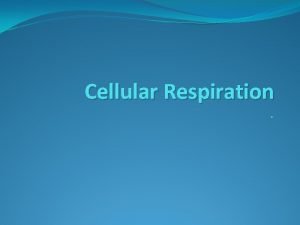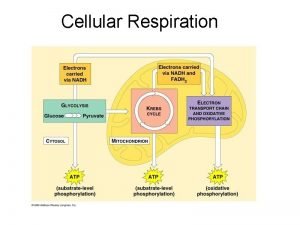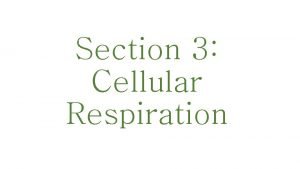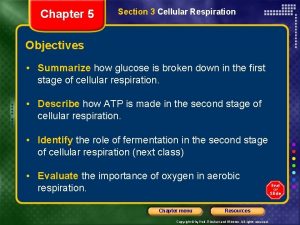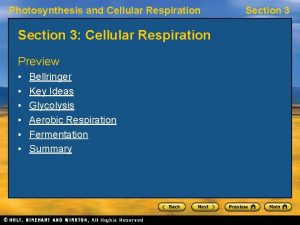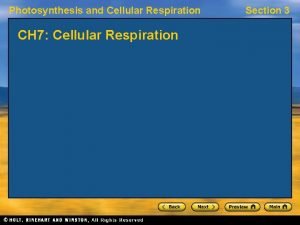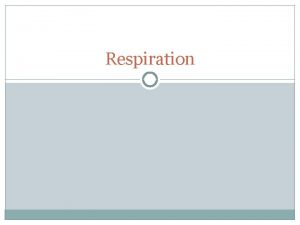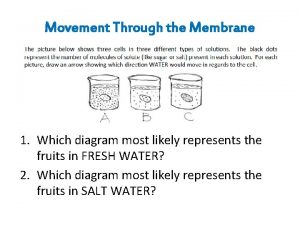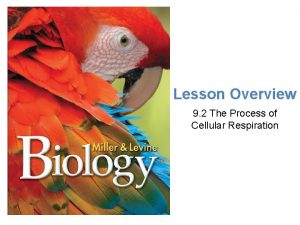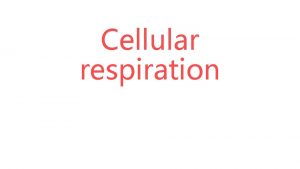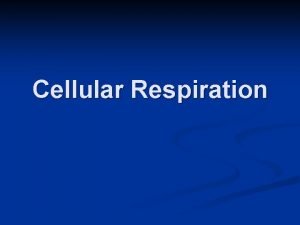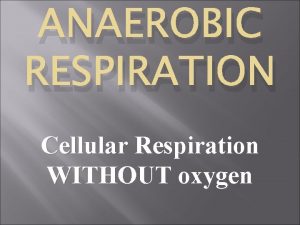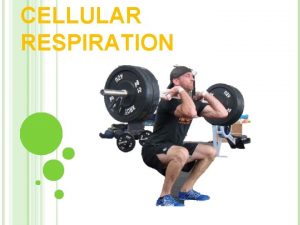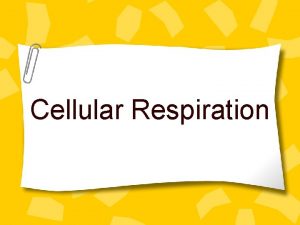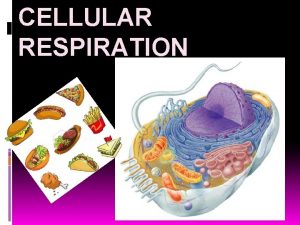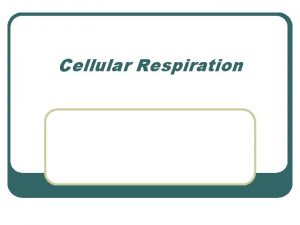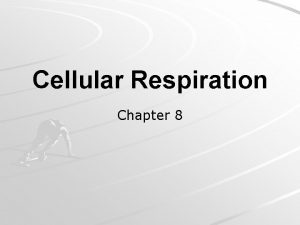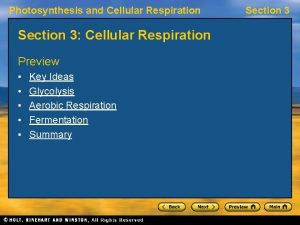Section 3 Cellular Respiration Cellular respiration occurs in






















- Slides: 22

Section 3: Cellular Respiration


Cellular respiration occurs in two main parts: 1. Glycolysis (anaerobic respiration) 2. Aerobic Respiration Anaerobic respiration- Does not require oxygen Aerobic respiration- Requires oxygen

Aerobic Respiration includes the Krebs cycle and Electron transport chain and is an aerobic process.

Glycolysis Glucose ATP Process by which glucose is broken down in the cytoplasm. ADP P ADP G 3 P Two molecules of ATP and two molecules of NADH is formed from each molecule of glucose that is broken down. 2 P G 3 P 2 ADP 2 P 2 ATP P NADH Pyruvate

1. Two phosphate groups from two molecules of ATP are joined to glucose. 6 carbon compound is broken down into two three carbon compounds. *notice that energy is used to start the reaction Glucose ATP P ADP G 3 P P

• G 3 P 2 P 2 ADP 2 ATP G 3 P 2 ATP NADH 2 P NADH

3. Two three carbon compounds are converted into two molecules of pyruvate. G 3 P 2 P * Four molecules of ATP are formed. G 3 P 2 ADP 2 ATP 2 P NADH Pyruvate

Krebs Cycle Recall that at the end of glycolysis, there was a net production of 4 ATP molecules and 2 pyruvate molecules. • In the presence of Oxygen, the pyruvate is transported into the mitochondrial matrix where it will be converted into carbon dioxide. • This process of converting pyruvate into carbon dioxide is called the Krebs cycle or the TCA cycle.

Prior to starting the Krebs cycle, the pyruvate from glycolysis is combined with Coenzyme A (Co. A) to form a 2 -carbon intermediate called Acetyl Co. A. NADH Pyruvate Acetyl Co. A then moves into the mitochondrial matrix.

The Krebs cycle begins with Acetyl Co. A combining with a 4 carbon compound to form a 6 carbon compound known as Citric Acid.


Finally Acetyl Co. A and citric Acid are generated and the cycle continues.

Remember that two molecules of pyruvate are formed during glycolysis, resulting in two turns of the Krebs cycle for each glucose molecule.


In aerobic respiration, this is the final step in the break down of glucose.


Electrons move along the mitochondrial membrane from one membrane protein to another.

As NADH and FADH 2 release electrons, the energy carriers are converted to NAD+ and FAD and hydrogen ions are pumped into the mitochondrial matrix across the inner mitochondrial membrane.

*Chemiosmosis and electron transport in cellular respiration are similar to these processes in photosynthesis Hydrogen ions then diffuse down their concentration gradient back across the membrane and into the matrix through the ATP Synthase molecules in chemiosmosis.

Oxygen is the final electron acceptor in the electron transport system in cellular respiration. Protons and electrons are transferred to oxygen to form water.

 The process of cellular respiration occurs in *
The process of cellular respiration occurs in * Cellular respiration occurs in
Cellular respiration occurs in Chapter 8 section 3 cellular respiration
Chapter 8 section 3 cellular respiration Section 3 cellular respiration
Section 3 cellular respiration Section 3 cellular respiration worksheet answers
Section 3 cellular respiration worksheet answers Section 3 cellular respiration
Section 3 cellular respiration Section 3 cellular respiration continued
Section 3 cellular respiration continued Cellular respiration redox
Cellular respiration redox The gray-brown haze often found over large cities is called
The gray-brown haze often found over large cities is called Chemiosmosis steps
Chemiosmosis steps Aerobic vs anaerobic
Aerobic vs anaerobic Definition of fermentation
Definition of fermentation Why is cellular respiration important
Why is cellular respiration important Complementary processes
Complementary processes Cellular respiration chemical equation
Cellular respiration chemical equation Amloplast
Amloplast Photosynthesis formula
Photosynthesis formula Starting materials for cellular respiration
Starting materials for cellular respiration Electron carriers in cellular respiration
Electron carriers in cellular respiration Overview of cellular respiration
Overview of cellular respiration Overview of aerobic respiration
Overview of aerobic respiration Cellular respiration
Cellular respiration Overview of cellular respiration
Overview of cellular respiration
